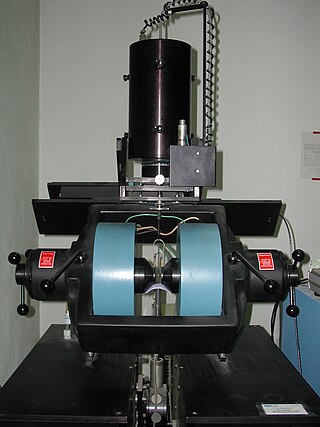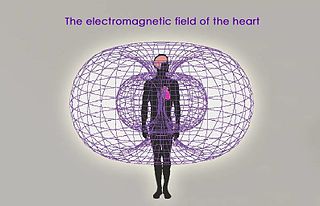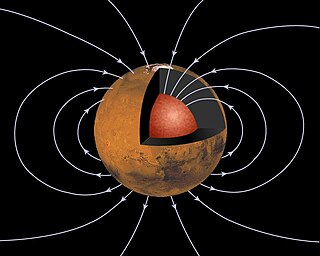
In physics, electromagnetism is an interaction that occurs between particles with electric charge via electromagnetic fields. The electromagnetic force is one of the four fundamental forces of nature. It is the dominant force in the interactions of atoms and molecules. Electromagnetism can be thought of as a combination of electrostatics and magnetism, two distinct but closely intertwined phenomena. Electromagnetic forces occur between any two charged particles, causing an attraction between particles with opposite charges and repulsion between particles with the same charge, while magnetism is an interaction that occurs exclusively between charged particles in relative motion. These two effects combine to create electromagnetic fields in the vicinity of charge particles, which can accelerate other charged particles via the Lorentz force. At high energy, the weak force and electromagnetic force are unified as a single electroweak force.

Magnetism is the class of physical attributes that occur through a magnetic field, which allows objects to attract or repel each other. Because both electric currents and magnetic moments of elementary particles give rise to a magnetic field, magnetism is one of two aspects of electromagnetism.

A SQUID is a very sensitive magnetometer used to measure extremely weak magnetic fields, based on superconducting loops containing Josephson junctions.

Magnetoencephalography (MEG) is a functional neuroimaging technique for mapping brain activity by recording magnetic fields produced by electrical currents occurring naturally in the brain, using very sensitive magnetometers. Arrays of SQUIDs are currently the most common magnetometer, while the SERF magnetometer is being investigated for future machines. Applications of MEG include basic research into perceptual and cognitive brain processes, localizing regions affected by pathology before surgical removal, determining the function of various parts of the brain, and neurofeedback. This can be applied in a clinical setting to find locations of abnormalities as well as in an experimental setting to simply measure brain activity.

Magnetite is a mineral and one of the main iron ores, with the chemical formula Fe2+Fe3+2O4. It is one of the oxides of iron, and is ferrimagnetic; it is attracted to a magnet and can be magnetized to become a permanent magnet itself. With the exception of extremely rare native iron deposits, it is the most magnetic of all the naturally occurring minerals on Earth. Naturally magnetized pieces of magnetite, called lodestone, will attract small pieces of iron, which is how ancient peoples first discovered the property of magnetism.
An ejection fraction (EF) is the volumetric fraction of fluid ejected from a chamber with each contraction. It can refer to the cardiac atrium, ventricle, gall bladder, or leg veins, although if unspecified it usually refers to the left ventricle of the heart. EF is widely used as a measure of the pumping efficiency of the heart and is used to classify heart failure types. It is also used as an indicator of the severity of heart failure, although it has recognized limitations.

Paleomagnetism is the study of magnetic fields recorded in rocks, sediment, or archeological materials. Geophysicists who specialize in paleomagnetism are called paleomagnetists.

Rock magnetism is the study of the magnetic properties of rocks, sediments and soils. The field arose out of the need in paleomagnetism to understand how rocks record the Earth's magnetic field. This remanence is carried by minerals, particularly certain strongly magnetic minerals like magnetite. An understanding of remanence helps paleomagnetists to develop methods for measuring the ancient magnetic field and correct for effects like sediment compaction and metamorphism. Rock magnetic methods are used to get a more detailed picture of the source of the distinctive striped pattern in marine magnetic anomalies that provides important information on plate tectonics. They are also used to interpret terrestrial magnetic anomalies in magnetic surveys as well as the strong crustal magnetism on Mars.
Bioelectromagnetics, also known as bioelectromagnetism, is the study of the interaction between electromagnetic fields and biological entities. Areas of study include electromagnetic fields produced by living cells, tissues or organisms, the effects of man-made sources of electromagnetic fields like mobile phones, and the application of electromagnetic radiation toward therapies for the treatment of various conditions.

Magnetocardiography (MCG) is a technique to measure the magnetic fields produced by electrical currents in the heart using extremely sensitive devices such as the superconducting quantum interference device (SQUID). If the magnetic field is measured using a multichannel device, a map of the magnetic field is obtained over the chest; from such a map, using mathematical algorithms that take into account the conductivity structure of the torso, it is possible to locate the source of the activity. For example, sources of abnormal rhythms or arrhythmia may be located using MCG.
Magnetobiology is the study of biological effects of mainly weak static and low-frequency magnetic fields, which do not cause heating of tissues. Magnetobiological effects have unique features that obviously distinguish them from thermal effects; often they are observed for alternating magnetic fields just in separate frequency and amplitude intervals. Also, they are dependent of simultaneously present static magnetic or electric fields and their polarization.
Radiobiology is a field of clinical and basic medical sciences that involves the study of the action of ionizing radiation on living things, especially health effects of radiation. Ionizing radiation is generally harmful and potentially lethal to living things but can have health benefits in radiation therapy for the treatment of cancer and thyrotoxicosis. Its most common impact is the induction of cancer with a latent period of years or decades after exposure. High doses can cause visually dramatic radiation burns, and/or rapid fatality through acute radiation syndrome. Controlled doses are used for medical imaging and radiotherapy.
David Cohen made many of the first pioneering measurements in the area of biomagnetism, although he was initially trained as a nuclear physicist.

Magnetofossils are the fossil remains of magnetic particles produced by magnetotactic bacteria (magnetobacteria) and preserved in the geologic record. The oldest definitive magnetofossils formed of the mineral magnetite come from the Cretaceous chalk beds of southern England, while magnetofossil reports, not considered to be robust, extend on Earth to the 1.9-billion-year-old Gunflint Chert; they may include the four-billion-year-old Martian meteorite ALH84001.
John Peter Wikswo, Jr. is a biological physicist at Vanderbilt University. He was born in Lynchburg, Virginia, United States.

Magnetomyography (MMG) is a technique for mapping muscle activity by recording magnetic fields produced by electrical currents occurring naturally in the muscles, using arrays of SQUIDs. It has a better capability than electromyography for detecting slow or direct currents. The magnitude of the MMG signal is in the scale of pico (10−12) to femto (10−15) Tesla (T). Miniaturizing MMG offers a prospect to modernize the bulky SQUID to wearable miniaturized magnetic sensors.
Superparamagnetic relaxometry (SPMR) is a technology combining the use of sensitive magnetic sensors and the superparamagnetic properties of magnetite nanoparticles (NP). For NP of a sufficiently small size, on the order of tens of nanometers (nm), the NP exhibit paramagnetic properties, i.e., they have little or no magnetic moment. When they are exposed to a small external magnetic field, on the order of a few millitesla (mT), the NP align with that field and exhibit ferromagnetic properties with large magnetic moments. Following removal of the magnetizing field, the NP slowly become thermalized, decaying with a distinct time constant from the ferromagnetic state back to the paramagnetic state. This time constant depends strongly upon the NP diameter and whether they are unbound or bound to an external surface such as a cell. Measurement of this decaying magnetic field is typically done by superconducting quantum interference detectors (SQUIDs). The magnitude of the field during the decay process determines the magnetic moment of the NPs in the source. A spatial contour map of the field distribution determines the location of the source in three dimensions as well as the magnetic moment.
Herman Carel Burger was a Dutch physicist who pioneered the field of electrocardiography and medical physics. A system of positioning of electrodes for electrocardiography is known as Burger's triangle.

The magnetic field of Mars is the magnetic field generated from Mars' interior. Today, Mars does not have a global magnetic field. However, Mars did power an early dynamo that produced a strong magnetic field 4 billion years ago, comparable to Earth's present surface field. After the early dynamo ceased, a weak late dynamo was reactivated ~3.8 billion years ago. The distribution of Martian crustal magnetization is similar to the Martian dichotomy. Whereas the Martian northern lowlands are largely unmagnetized, the southern hemisphere possesses strong remanent magnetization, showing alternating stripes. Our understanding of the evolution of the magnetic field of Mars is based on the combination of satellite measurements and Martian ground-based magnetic data.